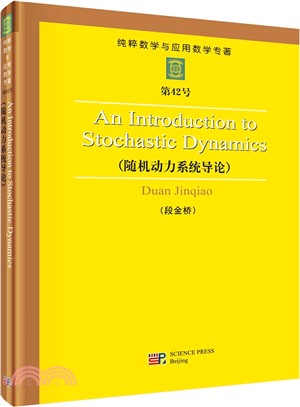相關商品
商品簡介
目次
書摘/試閱
商品簡介
隨機動力系統是一個入門較難的新興領域。本書是這個領域的一個較為通俗易懂的引論。在本書的第一部分,作者從簡單的隨機動力系統實際例子出發,引導讀者回顧概率論和白噪聲的基本知識,深入淺出地介紹隨機微積分,然後自然地展開隨機微分方程的討論。
目次
Chapter 1 Introduction
1.1 Examples of deterministic dynamical systems
1.2 Examples of stochastic dynamical systems
1.3 Mathematical modeling with stochastic differential equations
1.4 Outline of this book
1.5 Problems
Chapter 2 Background in Analysis and Probability
2.1 Euclidean space
2.2 Hilbert, Banach and metric spaces
2.3 Taylor expansions
2.4 Improper integrals and Cauchy principal values
2.5 Some useful inequalities
2.5.1 Young's inequality
2.5.2 Gronwall inequality
2.5.3 Cauchy—Schwarz inequality
2.5.4 Holder inequality
2.5.5 Minkowski inequality
2.6 Holder spaces, Sobolev spaces and related inequalities
2.7 Probability spaces
2.7.1 Scalar random variables
2.7.2 Random vectors
2.7.3 Gaussian random variables
2.7.4 Non—Gaussian random variables
2.8 Stochastic processes
2.9 Convergence concepts
2.10 Simulation
2.11 Problems
Chapter 3 Noise
3.1 Brownian motion
3.1.1 Brownian motion in R1
3.1.2 Brownian motion in Rn
3.2 What is Gaussian white noise
3.3 A mathematical model for Gaussian white noise
3.3.1 Generalized derivatives
3.3.2 Gaussian white noise
3.4 Simulation
3.5 Problems
Chapter 4 A Crash Course in Stochastic Differential Equations
4.1 Differential equations with noise
4.2 Riemann—Stieltjes integration
4.3 Stochastic integration and stochastic differential equations
4.3.1 Motivation
4.3.2 Definition of Ito integral
4.3.3 Practical calculations
4.3.4 Stratonovich integral
4.3.5 Examples
4.3.6 Properties of Ito integrals
4.3.7 Stochastic differential equations
4.3.8 SDEs in engineering and science literature
4.3.9 SDEs with two—sided Brownian motions
4.4 Ito's formula
4.4.1 Motivation for stochastic chain rules
4.4.2 Ito's formula in scalar case
4.4.3 Ito's formula in vector case
4.4.4 Stochastic product rule and integration by parts
4.5 Linear stochastic differential equations
4.6 Nonlinear stochastic differential equations
4.6.1 Existence, uniqueness and smoothness
4.6.2 Probabilitv measure Px and expectation Ex associated with an SDE
4.7 Conversion between Ito and Stratonovich stochastic differential equations
4.7.1 Scalar SDEs
4.7.2 SDE systems
4.8 Impact of noise on dynamics
4.9 Simulation
4.10 Problems
Chapter 5 Deterministic Quantities for Stochastic Dynamics
5.1 Moments
5.2 Probability density functions
5.2.1 Scalar Fokker—Planck equations
5.2.2 Multidimensional Fokker—Planck equations
5.2.3 Existence and uniqueness for Fokker—Planck equations
5.2.4 Likelihood for transitions between different dynamical regimes under uncertainty
5.3 Most probable phase portraits
5.3.1 Mean phase portraits
5.3.2 Almost sure phase portraits
5.3.3 Most probable phase portraits
5.4 Mean exit time
5.5 Escape probability
5.6 Problems
Chapter 6 Invariant Structures for Stochastic Dynamics
6.1 Deterministic dynamical systems
6.1.1 Concepts for deterministic dynamical systems
6.1.2 The Hartman—Grobman theorem
6.1.3 Invariant sets
6.1.4 Differentiable manifolds
6.1.5 Deterministic invariant manifolds
6.2 Measurable dvnamical svstems
6.3 Random dynamical systems
6.3.1 Canonical sample spaces for SDEs
6.3.2 Wiener shift
6.3.3 Cocycles and random dynamical systems
6.3.4 Examples of cocycles
6.3.5 Structural stability and stationary orbits
6.4 Linear stochastic dynamics
6.4.1 Oseledets' multiplicative ergodic theorem and Lyapunov exponents
6.4.2 A stochastic Hartman—Grobman theorem
6.5 Random invariant manifolds
6.5.1 Definition of random invariant manifolds
6.5.2 Converting SDEs to RDEs
6.5.3 Local random pseudo—stable and pseudo—unstable manifolds
6.5.4 Local random stable, unstable and center manifolds
6.6 Problems
Chapter 7 Dynamical Systems Driven by Non—Gaussian Levy Motions
7.1 Modeling via stochastic differential equations with Levy motions
7.2 Levy motions
7.2.1 Functions that have one—side limits
7.2.2 Levy—Ito decomposition
7.2.3 Levy—Khintchine formula
7.2.4 Basic properties of Levy motions
7.3 α—stable Levy motions
7.3.1 Stable random variables
7.3.2 α—stable Levy motions in R1
7.3.3 α—stable Levy motion in Rn
7.4 Stochastic differential equations with Levy motions
7.4.1 Stochastic integration with respect to Levy motions
7.4.2 SDEs with Levy motions
7.4.3 Generators for SDEs with Levy motion
7.5 Mean exit time
7.5.1 Mean exit time for α—stable Levy motion
7.5.2 Mean exit time for SDEs with α—stable Levy motion
7.6 Escape probability and transition phenomena
7.6.1 Balayage—Dirichlet problem for escape probability
7.6.2 Escape probability for α—stable Levy motion
7.6.3 Escape probability for SDEs with α—stable Levy motion
7.7 Fokker—Planck equations
7.7.1 Fokker—Planck equations in R1
7.7.2 Fokker—Planck equations in Rn
7.8 Problems
Hints and Solutions
Further Readings
References
Index
Color Pictures
1.1 Examples of deterministic dynamical systems
1.2 Examples of stochastic dynamical systems
1.3 Mathematical modeling with stochastic differential equations
1.4 Outline of this book
1.5 Problems
Chapter 2 Background in Analysis and Probability
2.1 Euclidean space
2.2 Hilbert, Banach and metric spaces
2.3 Taylor expansions
2.4 Improper integrals and Cauchy principal values
2.5 Some useful inequalities
2.5.1 Young's inequality
2.5.2 Gronwall inequality
2.5.3 Cauchy—Schwarz inequality
2.5.4 Holder inequality
2.5.5 Minkowski inequality
2.6 Holder spaces, Sobolev spaces and related inequalities
2.7 Probability spaces
2.7.1 Scalar random variables
2.7.2 Random vectors
2.7.3 Gaussian random variables
2.7.4 Non—Gaussian random variables
2.8 Stochastic processes
2.9 Convergence concepts
2.10 Simulation
2.11 Problems
Chapter 3 Noise
3.1 Brownian motion
3.1.1 Brownian motion in R1
3.1.2 Brownian motion in Rn
3.2 What is Gaussian white noise
3.3 A mathematical model for Gaussian white noise
3.3.1 Generalized derivatives
3.3.2 Gaussian white noise
3.4 Simulation
3.5 Problems
Chapter 4 A Crash Course in Stochastic Differential Equations
4.1 Differential equations with noise
4.2 Riemann—Stieltjes integration
4.3 Stochastic integration and stochastic differential equations
4.3.1 Motivation
4.3.2 Definition of Ito integral
4.3.3 Practical calculations
4.3.4 Stratonovich integral
4.3.5 Examples
4.3.6 Properties of Ito integrals
4.3.7 Stochastic differential equations
4.3.8 SDEs in engineering and science literature
4.3.9 SDEs with two—sided Brownian motions
4.4 Ito's formula
4.4.1 Motivation for stochastic chain rules
4.4.2 Ito's formula in scalar case
4.4.3 Ito's formula in vector case
4.4.4 Stochastic product rule and integration by parts
4.5 Linear stochastic differential equations
4.6 Nonlinear stochastic differential equations
4.6.1 Existence, uniqueness and smoothness
4.6.2 Probabilitv measure Px and expectation Ex associated with an SDE
4.7 Conversion between Ito and Stratonovich stochastic differential equations
4.7.1 Scalar SDEs
4.7.2 SDE systems
4.8 Impact of noise on dynamics
4.9 Simulation
4.10 Problems
Chapter 5 Deterministic Quantities for Stochastic Dynamics
5.1 Moments
5.2 Probability density functions
5.2.1 Scalar Fokker—Planck equations
5.2.2 Multidimensional Fokker—Planck equations
5.2.3 Existence and uniqueness for Fokker—Planck equations
5.2.4 Likelihood for transitions between different dynamical regimes under uncertainty
5.3 Most probable phase portraits
5.3.1 Mean phase portraits
5.3.2 Almost sure phase portraits
5.3.3 Most probable phase portraits
5.4 Mean exit time
5.5 Escape probability
5.6 Problems
Chapter 6 Invariant Structures for Stochastic Dynamics
6.1 Deterministic dynamical systems
6.1.1 Concepts for deterministic dynamical systems
6.1.2 The Hartman—Grobman theorem
6.1.3 Invariant sets
6.1.4 Differentiable manifolds
6.1.5 Deterministic invariant manifolds
6.2 Measurable dvnamical svstems
6.3 Random dynamical systems
6.3.1 Canonical sample spaces for SDEs
6.3.2 Wiener shift
6.3.3 Cocycles and random dynamical systems
6.3.4 Examples of cocycles
6.3.5 Structural stability and stationary orbits
6.4 Linear stochastic dynamics
6.4.1 Oseledets' multiplicative ergodic theorem and Lyapunov exponents
6.4.2 A stochastic Hartman—Grobman theorem
6.5 Random invariant manifolds
6.5.1 Definition of random invariant manifolds
6.5.2 Converting SDEs to RDEs
6.5.3 Local random pseudo—stable and pseudo—unstable manifolds
6.5.4 Local random stable, unstable and center manifolds
6.6 Problems
Chapter 7 Dynamical Systems Driven by Non—Gaussian Levy Motions
7.1 Modeling via stochastic differential equations with Levy motions
7.2 Levy motions
7.2.1 Functions that have one—side limits
7.2.2 Levy—Ito decomposition
7.2.3 Levy—Khintchine formula
7.2.4 Basic properties of Levy motions
7.3 α—stable Levy motions
7.3.1 Stable random variables
7.3.2 α—stable Levy motions in R1
7.3.3 α—stable Levy motion in Rn
7.4 Stochastic differential equations with Levy motions
7.4.1 Stochastic integration with respect to Levy motions
7.4.2 SDEs with Levy motions
7.4.3 Generators for SDEs with Levy motion
7.5 Mean exit time
7.5.1 Mean exit time for α—stable Levy motion
7.5.2 Mean exit time for SDEs with α—stable Levy motion
7.6 Escape probability and transition phenomena
7.6.1 Balayage—Dirichlet problem for escape probability
7.6.2 Escape probability for α—stable Levy motion
7.6.3 Escape probability for SDEs with α—stable Levy motion
7.7 Fokker—Planck equations
7.7.1 Fokker—Planck equations in R1
7.7.2 Fokker—Planck equations in Rn
7.8 Problems
Hints and Solutions
Further Readings
References
Index
Color Pictures
書摘/試閱
Chapter 1
Introduction
Noisy fluctuations are abundant in complex systems. In some cases, noise is not negligible, whereas in some other situations, noise could even be beneficial. It is desirable to have a better understanding of the impact of noise on dynamical evo¬lution of complex systems. In other words, it becomes crucial to take randomness into account in mathematical modeling of complex phenomena under uncertainty.
In 1908, Langevin devised a stochastic differential equation for the motion of Brownian particles in a fluid, under random impacts of surrounding fluid molecules. This stochastic differential equation, although important for understanding Brownian motion, went largely unnoticed in the mathematical community until after stochastic calculus emerged in the late 1940s. Introductory books on stochastic differential equations (SDEs) include [8,88,213].
The goal for this book is to examine and present select dynamical systems concepts, tools, and methods for understanding solutions of SDEs. To this end, we also need basic information about deterministic dynamical systems modeled by ordinary differential equations (ODEs), as presented in the first couple of chapters in one of the references [110,290].
In this introductory chapter, we present a few examples of deterministic and stochastic dynamical systems, then briefly outline the contents of this book.
1.1 Examples of deterministic dynamical systems
We recall a few examples of deterministic dynamical systems, where short time-scale forcing and nonlinearity can affect dynamics in a profound way.
Example 1.1 A double-well system.
Consider a one-dimensional dynamical system x = x - x3. It has three equilib¬rium states, -1,0 and 1,at which the vector field x - x3 is zero. Observe that
Note that x = x - x3 = -4,where the potential function V(x) = -gx2 + ^x4 has two minimal values (sometimes called “wells”),see Figure 1.1.
Figure 1.1 Plot of
A solution curve, or orbit, or trajectory, starting with x(0) = xo in (-1,0), decreases in time (because 士 < 0 on this interval) and approaches the equilibrium state - 1 as t ^ +oo, whereas an orbit starting with x(0) = xo in (-oo, -1), increases in time (because x > 0 on this interval) and approaches the equilibrium state - 1 as t +oo. Thus the equilibrium point {-1} is a stable equilibrium state and it is an attractor, i.e., it attracts nearby orbits. Likewise {1} is also an attractor. But the equilibrium state {0} is unstable and is called an repeller. See Figure 1.2 for a few representative solutions curves.
An orbit starting near one equilibrium state {-1} can not go anywhere near the other equilibrium state {1}, and vice versa. There is no transition between these two stable states.
If we only look at the solution curves in the state space, E1, wherestate xlives,
we get a state portrait, or as often called, a phase portrait.
Figure 1.3 shows the phase portrait for this double well system.
Figure 1.3 Phase portrait ior x = x - xz
Example 1.2 High-frequency (or short time-scale) forcing.
Consider a simple one-dimensional nonlinear system with time-periodic forcing with frequency u
Solution curves with frequency a; = 2 and a; = 10 are shown inFigures1.4 and 1.5,
respectively. The difference between low and high frequency forcing is visible.
Figure 1.4 Solutions of a; = -x -\-x3 e sin(ct^),x(0) = 0.5 with frequency cj = 2: e = 0 (no “oscillations” or in blue color) and e = 0.35 (with “oscillations” or in red color). See Figure 1.4 in the Color Pictures section at the end of this book
Example 1.3 Small nonlinearity leads to fundamental change in dynamics.
Consider a harmonic oscillator (a spring-mass system) of mass m and spring constant fc, under damping that is proportional to the cubic of velocity: mx = -kx - £xs, where 6: is a positive constant. For simplicity, we take m, k both equal to 1. This can also be achieved by rescaling the time. Thus,
Figure 1.5 Solutions of x = -x + x3 + esin(ojt),x(0) = 0.5 with frequency u) - 10: e = 0 (no “oscillations” or in blue color) and e = 0.35 (with “oscillations” or in red color). See Figure 1.5 in the Color Pictures section at the end of this book or equivalently,
where x is the displacement and y is the velocity of the oscillator. The equilibrium state is (0,0).
Without damping (e = 0),the model equations become
Dividing these two equations, we obtain
Integrating this equation, we see that the solution curves (x(t),y(t)) satisfy the conservation of energy for an arbitrary (non-negative) constant of integration, c. Thus, the solution curves are circles, see Figure 1.6.
In the case of damping, i.e., when e > 0, the energy is not conserved:
at all points except the equilibrium point (0,0). Thus, all orbits approach the equilibrium point (0,0) as t oo, no matter how small the damping coefficient e is, as shown in Figure 1.7. Comparing Figure 1.6 and Figure 1.7, we see that the dynamics, with or without damping, are drastically different.
Example 1.4 Simple pendulum.
Consi
Introduction
Noisy fluctuations are abundant in complex systems. In some cases, noise is not negligible, whereas in some other situations, noise could even be beneficial. It is desirable to have a better understanding of the impact of noise on dynamical evo¬lution of complex systems. In other words, it becomes crucial to take randomness into account in mathematical modeling of complex phenomena under uncertainty.
In 1908, Langevin devised a stochastic differential equation for the motion of Brownian particles in a fluid, under random impacts of surrounding fluid molecules. This stochastic differential equation, although important for understanding Brownian motion, went largely unnoticed in the mathematical community until after stochastic calculus emerged in the late 1940s. Introductory books on stochastic differential equations (SDEs) include [8,88,213].
The goal for this book is to examine and present select dynamical systems concepts, tools, and methods for understanding solutions of SDEs. To this end, we also need basic information about deterministic dynamical systems modeled by ordinary differential equations (ODEs), as presented in the first couple of chapters in one of the references [110,290].
In this introductory chapter, we present a few examples of deterministic and stochastic dynamical systems, then briefly outline the contents of this book.
1.1 Examples of deterministic dynamical systems
We recall a few examples of deterministic dynamical systems, where short time-scale forcing and nonlinearity can affect dynamics in a profound way.
Example 1.1 A double-well system.
Consider a one-dimensional dynamical system x = x - x3. It has three equilib¬rium states, -1,0 and 1,at which the vector field x - x3 is zero. Observe that
Note that x = x - x3 = -4,where the potential function V(x) = -gx2 + ^x4 has two minimal values (sometimes called “wells”),see Figure 1.1.
Figure 1.1 Plot of
A solution curve, or orbit, or trajectory, starting with x(0) = xo in (-1,0), decreases in time (because 士 < 0 on this interval) and approaches the equilibrium state - 1 as t ^ +oo, whereas an orbit starting with x(0) = xo in (-oo, -1), increases in time (because x > 0 on this interval) and approaches the equilibrium state - 1 as t +oo. Thus the equilibrium point {-1} is a stable equilibrium state and it is an attractor, i.e., it attracts nearby orbits. Likewise {1} is also an attractor. But the equilibrium state {0} is unstable and is called an repeller. See Figure 1.2 for a few representative solutions curves.
An orbit starting near one equilibrium state {-1} can not go anywhere near the other equilibrium state {1}, and vice versa. There is no transition between these two stable states.
If we only look at the solution curves in the state space, E1, wherestate xlives,
we get a state portrait, or as often called, a phase portrait.
Figure 1.3 shows the phase portrait for this double well system.
Figure 1.3 Phase portrait ior x = x - xz
Example 1.2 High-frequency (or short time-scale) forcing.
Consider a simple one-dimensional nonlinear system with time-periodic forcing with frequency u
Solution curves with frequency a; = 2 and a; = 10 are shown inFigures1.4 and 1.5,
respectively. The difference between low and high frequency forcing is visible.
Figure 1.4 Solutions of a; = -x -\-x3 e sin(ct^),x(0) = 0.5 with frequency cj = 2: e = 0 (no “oscillations” or in blue color) and e = 0.35 (with “oscillations” or in red color). See Figure 1.4 in the Color Pictures section at the end of this book
Example 1.3 Small nonlinearity leads to fundamental change in dynamics.
Consider a harmonic oscillator (a spring-mass system) of mass m and spring constant fc, under damping that is proportional to the cubic of velocity: mx = -kx - £xs, where 6: is a positive constant. For simplicity, we take m, k both equal to 1. This can also be achieved by rescaling the time. Thus,
Figure 1.5 Solutions of x = -x + x3 + esin(ojt),x(0) = 0.5 with frequency u) - 10: e = 0 (no “oscillations” or in blue color) and e = 0.35 (with “oscillations” or in red color). See Figure 1.5 in the Color Pictures section at the end of this book or equivalently,
where x is the displacement and y is the velocity of the oscillator. The equilibrium state is (0,0).
Without damping (e = 0),the model equations become
Dividing these two equations, we obtain
Integrating this equation, we see that the solution curves (x(t),y(t)) satisfy the conservation of energy for an arbitrary (non-negative) constant of integration, c. Thus, the solution curves are circles, see Figure 1.6.
In the case of damping, i.e., when e > 0, the energy is not conserved:
at all points except the equilibrium point (0,0). Thus, all orbits approach the equilibrium point (0,0) as t oo, no matter how small the damping coefficient e is, as shown in Figure 1.7. Comparing Figure 1.6 and Figure 1.7, we see that the dynamics, with or without damping, are drastically different.
Example 1.4 Simple pendulum.
Consi
主題書展
更多
主題書展
更多書展本週66折
您曾經瀏覽過的商品
購物須知
大陸出版品因裝訂品質及貨運條件與台灣出版品落差甚大,除封面破損、內頁脫落等較嚴重的狀態,其餘商品將正常出貨。
特別提醒:部分書籍附贈之內容(如音頻mp3或影片dvd等)已無實體光碟提供,需以QR CODE 連結至當地網站註冊“並通過驗證程序”,方可下載使用。
無現貨庫存之簡體書,將向海外調貨:
海外有庫存之書籍,等候約45個工作天;
海外無庫存之書籍,平均作業時間約60個工作天,然不保證確定可調到貨,尚請見諒。
為了保護您的權益,「三民網路書店」提供會員七日商品鑑賞期(收到商品為起始日)。
若要辦理退貨,請在商品鑑賞期內寄回,且商品必須是全新狀態與完整包裝(商品、附件、發票、隨貨贈品等)否則恕不接受退貨。

























